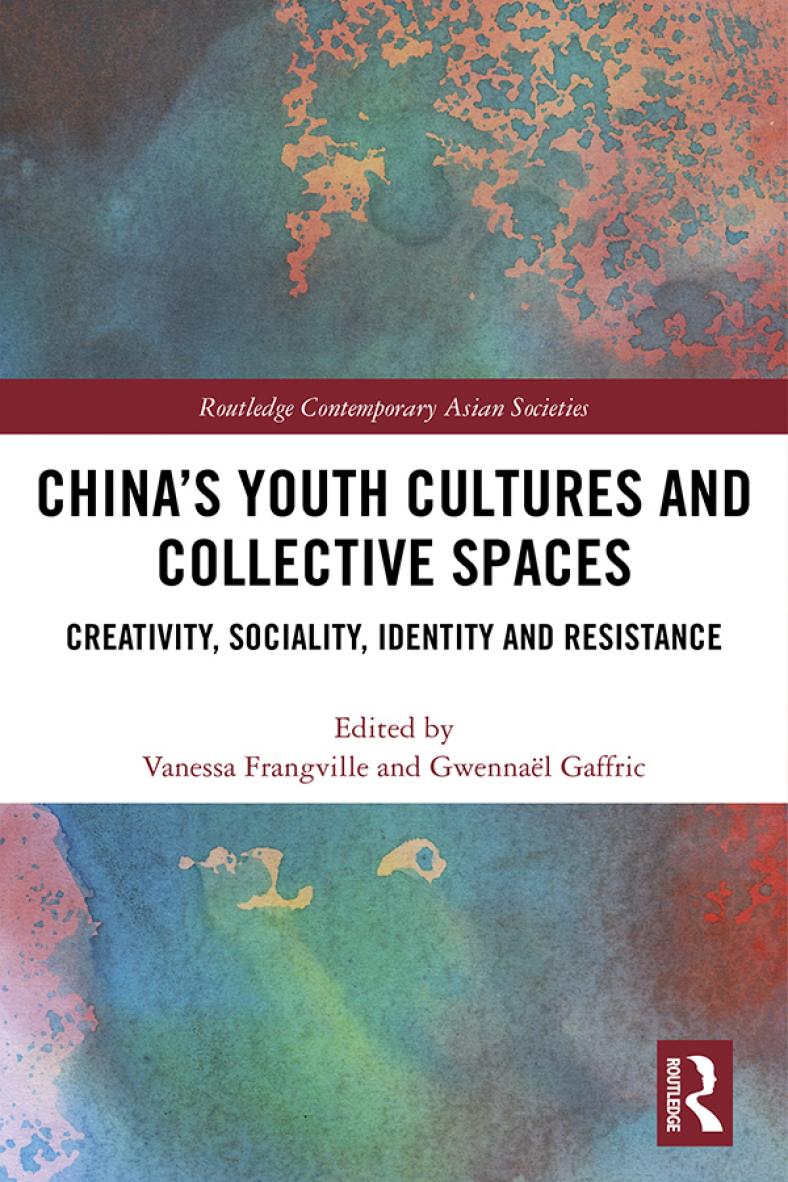Publications: Book chapters
-
 Biaoyan 表演. De la «performance» en Chine du maoïsme à la réforme, être en public et esthétique sociale. In: Vanessa Frangville, Françoise Lauwaert and Florent Villard (eds.), Les mots de la Chine. Rennes: Presses Universitaires de Rennes.Forthcoming
Biaoyan 表演. De la «performance» en Chine du maoïsme à la réforme, être en public et esthétique sociale. In: Vanessa Frangville, Françoise Lauwaert and Florent Villard (eds.), Les mots de la Chine. Rennes: Presses Universitaires de Rennes.Forthcoming -
 “Race, gender, and nation in right-wing nationalist discourse in Chinese cyberspace”, in Chenchen Zhang and Frederik Ponjaert ed. National Identity and the Youth in East Asia, Routledge.Forthcoming
“Race, gender, and nation in right-wing nationalist discourse in Chinese cyberspace”, in Chenchen Zhang and Frederik Ponjaert ed. National Identity and the Youth in East Asia, Routledge.Forthcoming -
 “Where Wild Grass Grow: Chinese Youth Culture Formation in Physical and Virtual Spaces”. In V. Frangville & G. Gaffric (eds), China’s Youth Cultures and Collective Spaces: creativity, Sociality, Identity and Resistance, Routledge, 2019.2019
“Where Wild Grass Grow: Chinese Youth Culture Formation in Physical and Virtual Spaces”. In V. Frangville & G. Gaffric (eds), China’s Youth Cultures and Collective Spaces: creativity, Sociality, Identity and Resistance, Routledge, 2019.2019This introduction presents an overview of the key concepts discussed in the subsequent chapters of this book. The book focuses on the Chinese Millennials born after the 1980s, it takes on the idea that youth is a social construction shaped by particular regional, cultural, and socio-economic factors rather than based on a strict bio-genealogical approach. It provides an insight on the complex interplay between youth cultures and spaces in China; but is also an innovative contribution on its own to the existing literature on contemporary Chinese society and culture that will interest scholars and students in Chinese and Asian studies, media studies, literature, film, art, sociology, and anthropology. The book explores a strong empirical base, providing unique concrete data on a variety of cultural practices across China, and on a combination of methodologies that result in a more efficient assessment of Chinese youth cultures.
-
 “From Homes to Parks, Shopping Malls and Theaters – Trajectory of Spatial Shift in Chinese Erciyuan Cosplay Practices”, in V. Frangville and G. Gaffric (eds) China’s Youth Cultures and Collective Spaces: Creativity, Sociality, Identity and Resistance, London: Routledge, p. 21-392019
“From Homes to Parks, Shopping Malls and Theaters – Trajectory of Spatial Shift in Chinese Erciyuan Cosplay Practices”, in V. Frangville and G. Gaffric (eds) China’s Youth Cultures and Collective Spaces: Creativity, Sociality, Identity and Resistance, London: Routledge, p. 21-392019In the 1990s, Chinese Millenials were nutured by globalized Japanese manga, anime, and games. The circulation and consumption of these forms resulted in the birth of Chinese Erciyuan (二次元, Second Dimension) culture, and later, Erciyuan Millennials became the actors and audience of Cosplay, which has thrived and, in less than two decades, become the most popular cultural practice in the Chinese cultural industry. Apart from the development of Cosplay, a spatial shift can be observed in the display of this particular culture: from home to parks, from parks to shopping malls and theaters. The varied spaces have reshaped the ways Cosplay is practiced, forms of Cosplay performance and utilities, and the strategies of these spaces. Based on fieldwork undertaken in Beijing in 2008, 2010, 2012, this chapter explores what led to the transitions of spaces and how it effected practices of Cosplay in terms of the choice, utilization, and negotiation of spaces as well as the creation of Cosplay practices.
-
 “Representations of Sociability in Public Spaces in the Uyghur Web Series Anar Pishti: Resilience, Resistance, and Reinvention”, in V. Frangville and G. Gaffric, China’s Youth Cultures and Collective Spaces: Creativity, Sociality, Identity and Resistance. London: Routledge.2019
“Representations of Sociability in Public Spaces in the Uyghur Web Series Anar Pishti: Resilience, Resistance, and Reinvention”, in V. Frangville and G. Gaffric, China’s Youth Cultures and Collective Spaces: Creativity, Sociality, Identity and Resistance. London: Routledge.2019This chapter examines the popular Uyghur online series Anar Pishti. A close analysis of selected vignettes emphasizes collective outdoor areas such as parking lots, residential compounds, and streets are associated with danger and highly competitive interactions. Specifically, I examine three types of random encounters in the streets of Ürümchi: Uyghurs and Han, within the Uyghur community, Uyghurs and authorities. I argue that Anar Pishti producers resourcefully develop new means of communication and community building through collective laughter, creatively attesting to both hope and resilience in times of crisis for the Uyghurs.
-
 “Collective space/time travel in Chinese cyberliterature”. In V. Frangville & G. Gaffric (eds), China’s Youth Cultures and Collective Spaces: creativity, Sociality, Identity and Resistance, Routledge, 2019, pp. 189-202.2019
“Collective space/time travel in Chinese cyberliterature”. In V. Frangville & G. Gaffric (eds), China’s Youth Cultures and Collective Spaces: creativity, Sociality, Identity and Resistance, Routledge, 2019, pp. 189-202.2019In this chapter, I explore the creation of collective relationships and their political meaning in cyberspace through cyberliterature, a cultural sector that has been booming in China for at least two decades. I focus mainly on two particular fictional genres, which are very popular among readers of Chinese web literature: time-travel fiction (chuanyue xiaoshuo 穿越小说) and alternative history fiction (jiakong lishi xiaoshuo 架空历史小说). I discuss how Chinese cyber-time-travel fiction suggests new ways of making literature within a virtual space. For this purpose, I analyze more specifically Lingao qiming (临高启明) series, a time-travel fiction series whose genesis comes from a discussion on an online forum whose users imagine that a group of young contemporary people succeed through a wormhole to return to the time of the Ming Dynasty, where they try to establish an independent political enclave. I question the modalities of participation to the collective writing project of the series and the reception by the Chinese authorities of this type of narrative, as well as the latent subversive content that it is possible to discern behind these seemingly naive and popular novels. Through the example of time travel through an alternative history fiction, and of the extended universes to which they give birth, I observe the collective and interactive dimension of this new type of creation and discuss how the study of cyberliterature, both in its creation and reception aspects, reveals innovative means of investing collective (cyber)space and creating social networks.
-
 “Afterthoughts. Rethinking the Spatial Politics of Presence in China's Youth Cultures”. In: Vanessa Frangville and Gwennaël Gaffric (eds.), China’s Youth Cultures and Collective Spaces: Creativity, Sociality, Identity and Resistance. London: Routledge, pp. 235-247.2019
“Afterthoughts. Rethinking the Spatial Politics of Presence in China's Youth Cultures”. In: Vanessa Frangville and Gwennaël Gaffric (eds.), China’s Youth Cultures and Collective Spaces: Creativity, Sociality, Identity and Resistance. London: Routledge, pp. 235-247.2019This conclusive chapter offers some final reflections on the forms of youth expressive presence encountered throughout the book, which existing narratives of assertion do not aptly capture. It tracks the ambivalent political significance of the spatial and cultural practices under scrutiny, arguing that the modes upon which presence unfolds modulate its very performative force and political potential. The chapter ultimately reflects on the positive affectivity (e.g., fun, playfulness, ‘positive energy’) described in several chapters, to ask whether these dominant tonalities of China’s youth cultures might constitute an impassable, undisrupted threshold toward more overt demands for change and alternative imaginations of the future.